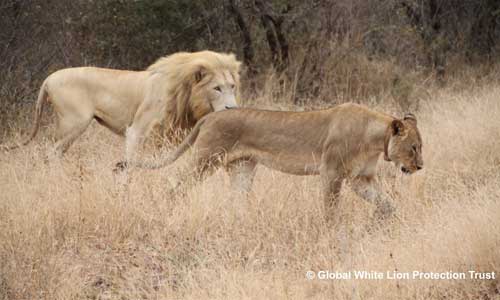Protecting an iconic species in South Africa
By Jason A. Turner
|
|
The white lion is a rare colour variant of the African lion Panthera leo that has a white coat colour with either yellow, blue or green eyes, and has only ever been recorded in the wild in the Timbavati Private Nature Reserve (TPNR) and southern Kruger National Park (KNP) in South Africa. The white coat colour is not due to albinism, but rather leucism resulting from a double recessive allele [1]. The presence of white lions was documented for the first time in the southern KNP in 1959 and in the Timbavati Private Nature Reserve (TPNR) in 1975.
From the 1970s onwards, prized for their rarity, the white lions and many ‘normal’ coloured (tawny) lions carrying the white lion gene were removed from the wild and put into captive breeding and hunting programs and sent to zoos and circuses around the globe. No adult white lion had been seen in their natural habitat since 1994. The WLT therefore initiated a world-first re-establishment of white lions within their natural habitat in 2004, based on successful reintroduction techniques. The wild born offspring of rehabilitated white lions were integrated with resident wild tawny lions, and released through a soft release process. We have successfully established three prides of high genetic integrity that are hunting self-sufficiently in their natural habitat, at a predation rate comparable to the wild tawny lions in the same habitat [1] [2]. The genetic marker determining the white colouration was identified in a collaborative study with 5 other countries in October 2013 [3], and is being used to ensure genetic integrity and ultimately to determine the frequency of occurrence of the gene in the wild population.
Subsequently, white cubs were born in the Timbavati Private Nature Reserve in 2006, 2008, 2009, 2011, 2012 and 2013, and in the Nwanetsi Area of Kruger National Park in 2014 and 2015, confirming that white lions are a natural occurrence and the recessive gene is still present in the wild population.
The primary aim of the White Lion Trust is to harness the cultural importance of white lions to local indigenous communities [4], to help protect the Kruger to Canyon (K2C) Biosphere and the greater lion population in this region. This approach is based on the international precedent of the Kermode Bear (Ursus americanus kermodei) in British Columbia (Western Canada), whereby this rare white variant of the Black Bear (Ursus americanus) has been declared a critically endangered subspecies due to its conservation and cultural value, such that the Kermode Bear is being used as a flagship species for protecting a 4000 000 ha wilderness area [5]. As with the Kermode Bear, by protecting the white lions the entire lion population within their endemic area would be protected.
In light of the proposed downlisting of the conservation status of lions in South Africa by the Department of Environmental Affairs (DEA) from Vulnerable to Least Concern on the list of Threatened or Protected Species (TOPS), the Global White Lion Protection Trust (WLT) asserts that the survival of lions in the K2C Biosphere is likely to come under threat, and the white lion is the ideal capstone animal to prevent this. Note: as the proposed policy stands for the management of lions in South Africa [6], the downlisting will increase the supply and therefore demand of wild lion trophies and especially lion bones, increasing poaching and illegal hunting and threatening the future of wild lion populations in South Africa.
To learn more about white lions and conservation efforts, visit the Global White Lion Protection Trust's website
1. Turner, J. A., Vasicek, C. A., & Somers, M. J. (2015). Effects of a colour variant on hunting ability: the white lion in South Africa. Open Science Repository Biology, Online(open-access), e45011830. doi:10.7392/openaccess.45011830.
2. Valeix, M. (2015). Review of “Effects of a colour variant on hunting ability - the white lions in South Africa”: http://www.open-science-repository.com/review-of-the-article-effects-of-a-colour-variant-on-hunting-ability-the-white-lion-in-south-africa.html.
3. Yun Sung Cho et al. (2013). The tiger genome and comparative analysis with lion and snow leopard genomes. Nature Communications 4: 2433, DOI: 10.1038/ncomms3433.
4. Tucker, L. (2003). Mystery of the White Lions: Children of the Sun God. White River: Npenvu Press.
5. Marshall, H. D. & K. Ritland. (2002). Genetic diversity and differentiation of Kermode bear populations. Molecular Ecology, 11: 685-697.
6. Funston, P.J., M. Levendal, & Department of Environmental Affairs. (2014). Draft Biodiversity Management Plan for the lion (Panthera leo) in South Africa. https://www.environment.gov.za/sites/default/files/gazetted_notices/nemba_africanlion_
managementplan_gn351g38706.pdf
Jason A. Turner is a lion ecologist at the Global White Lion Protection Trust in South Africa.
